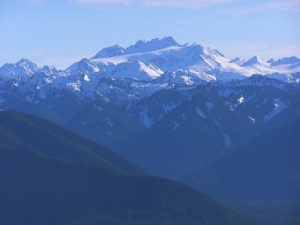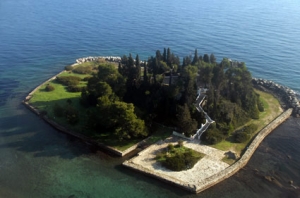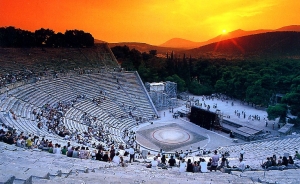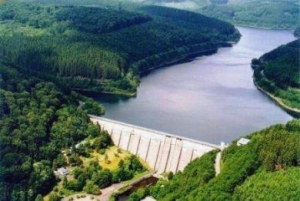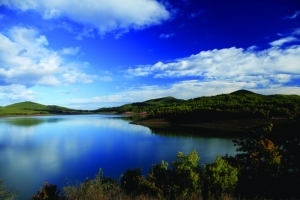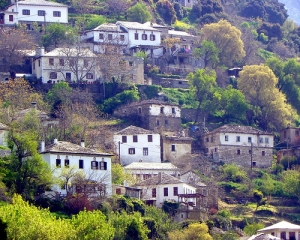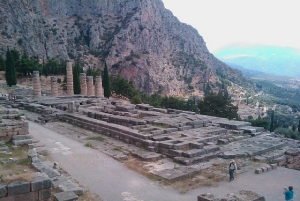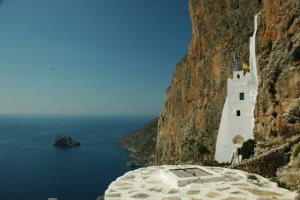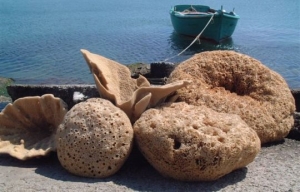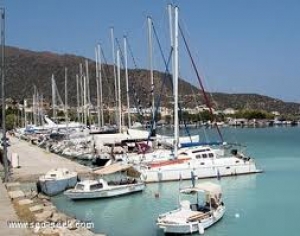Of all the islands of Greece, the one that lies the closest to Albania and Italy is Kerkyra and it is connected by boats to both countries. From a financial perspective, the largest percentage of the inhabitants of Kerkyra work in agriculture or in tourism. They mainly cultivate olives, vines, fruit trees, potatoes and citrus fruits. Kerkyra has an important animal production as well; bee breeding and bird breeding have also been developed. With regards to industrial production there are olive oil factories, weaving factories, paper mill factories, dairy products factories, industry of pasta and ship yards. However tourism is the Prefecture most important industry and the islands of Kerkyra have become cosmopolitan travel destinations, famous all over the world.
A green rock in the middle of the sea is Kerkyra’s trademark. The legendary Podikonisi, at the entrance of the Chalkiopoulo lagoon is one of the sights you can admire but you can’t touch. As it is a natural museum, visitors are forbidden to walk and stay on its grounds so that the virgin habitat is kept intact. If you insist on visiting the island you should know that you are going to stay there just for a few minutes and under the guards’ strict monitoring. Unless you are lucky and you are in Kerkyra on the 6th of August, day of celebration for the monastery "The Transformation of the Saviour", when you can visit for adoration. It is the only day of the year that it is allowed to enter the interior of the island.
To read more, please visit kerkyrainfo.gr.
LIFE & CULTURE
XpatAthens
Mount Olympus: Home Of The Gods
Mount Olympus is where life blends with mythology and the idealized archetypes with the aspects of the multi-faceted human psyche. Any climb to Mount Olympus starts from the town of Litochoro. Traditionally regarded as the imaginary abode of the Greek gods, it inspires respect not only by virtue of its height (the highest peak cuts the sky at 2,919 meters), but primarily by its divine mystery.
It is here that Zeus mounted his throne, Hades remorselessly ruled the Underworld, and Poseidon rocked the seas.
And although the myth of Sisyphus cursed to endlessly roll a giant boulder up a hill, or Prometheus, bound to a rock and having his liver eaten by an eagle seem nothing but fairy tales, a strenuous climb up the range may well give you a creepy shiver running down your spine.
Mytikas, Olympus' highest peak at 2917 meters was reached in 1913 by Christos Kakalos of nearby Litohoro and Swiss climbers Frederic Boissonas and Daniel Baud-Bovy. The mountain is rich in tree and plant life, supporting over 1700 species, some very rare. The main village of Litohoro is connected by bus from Athens and Thessaloniki and by train though the station is 9 kilometers from the village.
Climbing Olympus takes two days but you can easily spend longer if you like. There are a large number of decent trails and you won't need special equipment or experience. You can get a map from the EOS office in Litohoro where English is spoken or the SEO office where it may not be. It may not matter because the map is in Greek but with a little bit of effort you can decipher the alphabet. Anyway you will need it, no matter what language it is in. Remember that people have died climbing this mountain so don't take it too lightly. You will need warm clothes, even in the summer. Sunscreen is also a necessity and decent shoes. You will be able to stay in refuges overnight.
During the August Olympus Festival plays are performed at the restored ancient theatre.
Source: Magical Journeys
Kerkyra Island - Podikonisi
Kerkyra, also known as Corfu, is located on the Heptanese and is the biggest Prefecture of the Ionian Islands region in terms of population. The extension of its area is 641 square kilometers and it has a population of 107,592 inhabitants. It is constituted by Kerkyra, the second largest island of the Ionian sea after Cephalonia, and by the small islands Othoni, Mathraki, Erikoosa and the group of the Paxi – Antipaxi islands.
Epidavros – A Quick Day-Trip from Athens
Amidst the blue of the Saronic Gulf, well protected on its own smaller gulf, where the scent from the valley's orange blossoms meets the sea breeze in its picturesque friendly port, Ancient Epidavros, traditional yet modern, both tranquil and cosmopolitan, is always ready to welcome travelers whatever the season. Midway along the east coast of the Argolida district, easy to reach by highway via the Corinth Canal, the little town is built on the site of the ancient city-state of Epidavros.
Quiet pleasant people, occupied in fishing, tending orange groves and tourism, a mild climate, beautiful surroundings and a sound infrastructure provide the framework for all that one needs for a quick get-away from Athens.
Its sheltered location and natural surroundings, the beauty of the landscape and fertility of the soil, attracted not only men but also gods. It was here that Asklepios' most splendid sanctuary was situated. Here yet another important nucleus of ancient Greek civilization was created.
Some History
The first inhabitants of the area were the Carians and then later the Dorians. The city took part in the Trojan War; it fought against the Persians at Plataea and Salamis and found itself on the side of the Spartans in the Peloponnesian War. Good sailors and merchants, the people of Epidavros founded colonies and raised their town to a high level. Their civilization came to light during excavations on the peninsula that bisects the Bay of Epidavros, the "island" as the locals call it today.
We can find remains from the Acropolis with Roman walls, ruins of a palace and houses, columns from the Doric temple and nearby, Mycenaean tombs; while under the sea, not very deep, lies a section of the ancient city. Its jewel however can be found on the west side of the peninsula: the ancient theatre, or the "little one”, as it has been dubbed, to distinguish it from the "big one” in the Sanctuary of Asklepios. Built in the 4th century BC, it was dedicated to Dionysos, but for centuries remained buried under six meters of earth. In 1971, archaeologists began their digs. And today, elegant with its stone seats, it not only reaffirms the achievements of ancient civilization it also plays host to marvelous concerts.
Some Ancient History
Epidaurus was independent of Argos and not included in Argolis until the time of the Romans. With its supporting territory, it formed the small territory called Epidauria. Reputed to be the birthplace of Apollo's son Asclepius, the healer, Epidaurus was known for its sanctuary situated about five miles (8 km) from the town, as well as its theater, which is once again in use today. The cult of Asclepius at Epidaurus is attested in the 6th century BC, when the older hill-top sanctuary of Apollo Maleatas was no longer spacious enough.
The asclepieion at Epidaurus was the most celebrated healing center of the Classical world, the place where ill people went in the hope of being cured. To find out the right cure for their ailments, they spent a night in the ‘enkoimeteria’, a big sleeping hall. In their dreams, the god himself would advise them what they had to do to regain their health. Found in the sanctuary, there was a guest house for 160 guestrooms. There are also mineral springs in the vicinity which may have been used in healing.
The Famous Ancient Theater
The prosperity brought by the Asklepieion enabled Epidaurus to construct civic monuments too: the huge theatre that delighted Pausanias for its symmetry and beauty, which is used once again for dramatic performances, the ceremonial Hestiatoreion (banqueting hall), baths and a palaestra. The theater was designed by Polykleitos the Younger in the 4th century BC. The original 34 rows were extended in Roman times by another 21 rows. As is usual for Greek theatres (and as opposed to Roman ones), the view on a lush landscape behind the skênê is an integral part of the theatre itself and is not to be obscured. It seats up to 15,000 people.
The theatre is marveled for its exceptional acoustics, which permit almost perfect intelligibility of unamplified spoken word from the proscenium or skênê to all 15,000 spectators, regardless of their seating. Famously, tour guides have their groups scattered in the stands and show them how they can easily hear the sound of a match struck at center-stage. A 2007 study by Nico F. Declercq and Cindy Dekeyser of the Georgia Institute of Technology indicates that the astonishing acoustic properties are either the result of an accident or the product of advanced design: The rows of limestone seats filter out low-frequency sounds, such as the murmur of the crowd, and amplify/reflect high-frequency sounds from the stage.
Source: Epidavros.net
Traveling Back To Granddad’s Greek Home
People were watching us. Staring, actually. My 17-year-old daughter was uncomfortable, as was her mother, my modest and distinctly non-Greek wife. On the other hand, our 16-year-old son, who shares his father’s Zorba-like hamminess, was lapping up the attention. We were walking down the narrow streets of Lidoriki, a small village in the mountains of central Greece. Foreigners are rare here, Americans rarer still.
Lidoriki is a lovely little Greek village, unencumbered by tourists, with just a few stores. Each road spills into a large town square flanked by four or five restaurants. At night, everyone in and around Lidoriki comes to this square to do what Greeks do: eat, drink, talk, eat, drink, argue.
Lidoriki is about 40 miles from Delphi — home of the Oracle. Some Athenians keep summer homes here to escape the city heat. The village’s Mornos reservoir supplies Athens with its drinking water. So Lidoriki is pretty important to the capital city. It’s also pretty important to me.
This was my grandfather’s home. James Gardikys-Karandreas left Lidoriki 102 years ago to come to America. He was 13, alone and spoke little English. So he didn’t protest when they changed his name at Ellis Island from the unwieldy Gardikys-Karandreas to the manageable and WASP-y sounding Carden.
I’ve always figured that an immigration officer had just processed a British family from, say, Cheshire, and the name Carden had stuck with him, so he stuck it on my grandfather. Thus, I am a Carden, as is my family. But not one week last summer. That week, the Gardikys-Karandreases were going home.
Home to Greece.
First, let’s get the islands thing out of the way. Yeah, Santorini’s beautiful, Crete mystical, Patmos spiritual (St. John wrote the Book of Revelation there). Most tourists fly to Athens, cram onto a ship at the port of Piraeus and make the day-long trip to one or more of these splendid sanctuaries. And that’s where they stay. Big mistake.
The real Greece is the mainland. The Acropolis, Delphi, Nafplio. Olympus, home of the gods. And Lidoriki, home of the Gardikys-Karandreases.
We arrived in Athens last June at the height of the riots over Greece’s financial situation, which learned observers viewed as a contemporary expression of Greece’s role as the birthplace of democracy. Maybe. To me, it sounded a lot like my grandfather and his friends screaming politics at each other at our local diner so we never felt threatened.
Our cabbie from the airport was a lot less concerned about Greek debt than the Western media are. “We survived 400 years under the Turks, so who cares if we owe some banks some money?” he shrugged. The bartender at the hotel: The Germans “occupied us 70 years ago; now we take their money. That’s okay.”
Next to the Acropolis, the demonstrations were the best part of Athens. Loud, animated, scruffy-looking kids flanked by sleek, well-coiffed cops. Vendors selling cheesy belts and bags to tourists. Live Grecian theater at its best.
If you only have a week or so in Greece, then you don’t need more than a day or two in Athens. The Acropolis and Parthenon are true wonders of the world and must be experienced. The Plaka marketplace at the foot of the ruins is touristy but alive with great restaurants and better people watching.
To read more, please visit washingtonpost.com
By Bob Carden
Lake Plastira
The Lake Plastiras area is known for its spectacular natural beauty. The lake itself is man-made and was built in 1959 by Prime Minister Nikolaos Plastiras, for whom the lake and its dam are named. The lake is set at an altitude of about 800 meters in the Agrafa mountain range making it a place with magnificent views no matter where you stop to look.
Covering an area of about 24km2, it is surrounded by natural beauty, beaches, restaurants, hotels and many trails within its vast forest. Here you can walk, drive or bike along fir, oak and chestnut trees down shady lanes with openings to views of immense height and the vast plains below. Fishing, sailing, kayaking, river rafting, hiking, horseback riding, mountain climbing, cross country skiing and jeep tours are only a few of the ways you can enjoy the natural beauty of this area.
There are several small villages surrounding the lake, each one preserving the history of this land. The villages of Kryoneri and Kalivia of Pezoula are well developed for tourism. Here you will find hiking tracks, hotels, places to rent various equipment for a variety of sporting activities, organized outdoor areas and the beaches of the lake.
The tourist haven and best-known village, Neochori, is worth visiting, as it was built on a slope and offers the best views of the lake. It also offers a visit to its botanical gardens, which house plants making up the ecosystem of the local area. The communities of the lake offer an Environmental Education Center, an Educational Forest, Ecological Paths, Botanical Gardens, Hydro-biological Station, Observatory, Alpine Shelters, an outdoor activity center and renting of bikes, canoes and water bicycles.
There are also important monuments and places of interest in the wider region such as the Monastery of Korona, the Sacred Monastery of Pelekiti, the Sacred Monastery of Petra, the Gaki cave and the Kaimakia cave.
Visitors to Plastiras Lake can buy local products from the producers of the region along the road. You will find honey, spoon sweets, frumenty, garden products, wine, raki and more. No matter what time of year you choose to visit Lake Plastiras, you will be swept off your feet.
To read more, please visit windmillstravel.com
Portaria: A Beautiful Traditional Pelion Village
Portaria in Pelion (Pilio) is one of the most beautiful, interesting and unique traditional villages in this entire region of Central Greece. With its stunning natural beauty, fresh spring waters, impressive traditional mansions and winding cobble-stoned paths, Portaria is surely one of the few places where you can find tranquility and beauty right in the heart of Greece.
The geographic location of Portaria is perfect for holidays all year round. Located only 13km from the city of Volos, and at an altitude of 650m, right on Mount Pelion, Portaria is an ideal starting point from which to explore all of this wonderful mountain area of Greece.
Pelion has many beautiful beaches and sea waters, which are ideal during the hot summer months. And during the winter season, the Ski Center of Agriolefkes, just a short distance from Portaria, is a very popular destination for visitors.
Portaria is a village that you really have to visit to appreciate. We are sure that once you have visited Portaria, we will have captured your heart and imagination, and that you will return here time and time again in the future.
Festivals in Portaria
During the summer months in Portaria, there are several cultural activites that take place, which everyone is welcome to attend and enjoy.
In July, the "International Dance Festival for Children" takes place, and in August the "International Dance Festival" begins.
These events are a wonderful opportunity to come and enjoy music and dance from all over the world, and join in the celebrations that take place suring these festivals.
During the last week of August, there is the revival of a traditional Pelion-style wedding that takes place.
In Autumn, there is the "Ascent of Portaria", which is organised by the car club of Volos.
Festivals aside, there is one stop which you should make, and that is to the "Komboloi Museum of Portaria", where you can come and see the many kombolois on display as well as purchase a set for yourself.
To read more, please see visitportaria.com
A Day Trip In Central Greece
Greece is famous for its beautiful beaches and islands. But it also has unique landscapes on the mainland. Central Greece is not a well know destination for travelling. It is 2 hours away from Athens and has a lot to offer. One of my favorite day trips includes a visit to the archaeological site of Delphi, eating and swimming at Antikyra and an evening visit to the Monastery of Osios Loukas which is a World Heritage Monument of UNESCO. Rent a car and follow me on this day trip!
Delphi is about two hours away from Athens. The scenery of the archaeological site is really unique. Ancient Greeks thought that this was the center of the Earth (“omfalos” = bellybutton, as it was called). The famous Oracle of Pythia, the Temple of Apollo and the museum are a must to visit. Wear a hat, take a bottle of water with you and start climbing the main road in the archaeological area. The Stadium is really high, but the view is totally worth it. Find some shade and enjoy the view, take a few breaths of ancient history.
To read more, please visit blog.visitgreece.gr
By Christos Loukas
Amorgos
Amorgo island’s top attraction is the 10th century cliffside monastery of Panayia Hozoviótissa, dedicated to the Presentation of the Virgin, a spiritual haven and one of the most important ecclesiastic monuments in Greece. Set high up on the steepest rock of Mt. Profitis Elias, 300m above the Aegean, the building resembles a “chest of drawers”, according to the French explorer Pitton de Tournefort.
Visible only from the sea, the monastery is an example of human triumph over nature, a wonder that will leave you awestruck.
According to tradition, the monastery was founded by the Byzantine Emperor Alexios I Komnenos in 1088, during the period of Iconoclasm, when the icon of Panayia was sent by a woman from Hozovo from Palestine and miraculously made its way to Amorgós. According to another version, the Monastery was founded in the 9th century by monks from Palestine and was later renovated by the emperor Alexios I Komnenos.
The monastery has eight floors connected by narrow stone staircases carved into the rock. 350 steps lead you to the monastery, the interior of which is like a labyrinth. The cells of the monks are all carved into the rock to form a unique example of traditional architecture. Two icons of the Virgin Mary and other religious relics from the period of Alexios Komninos have been found at the monastery. Important heirlooms such as a manuscript, gospels, vestments and ecclesiastical utensils dating from the 10th to the 19th century are also on display.
To read more, please see visitgreece.gr
Sponge Fishermen From Kalymnos
The waters surrounding Kalymnos Island seem endless and are the deepest shade of blue; the famous local sponge fishermen are inextricably linked with the well kept secrets and naval stories that border on myth. Fearless strong men wrestle with the elements, in search of the hidden treasures in the sea’s most distant corners…. Kalymnos Island is famous worldwide as home to divers and sponge harvesters.
For locals, sponge fishing used to be their source of income; a “mission impossible” that only the fittest and bravest could pursue successfully.
The centuries-old tradition in sponge fishing determined the island’s identity and contributed significantly to its financial prosperity. Enterprising local tradesmen sold their valuable harvest in Syros, Nafplio and Constantinople and travelled as far as Odessa, St Petersburg, Moscow, Trieste and the Middle East…
Diving Methods
Historical records of the 1800s help us “dive” into the “travels of life or death” of the daring sponge fishermen who ventured into the open sea and started exploring the sponging grounds early in the springtime, carrying with them only a few provisions and their stamina. These legendary men went “skin diving”, reaching depths of 30 metres, shoved by a heavy skandalopetra i.e. a piece of marble that helped them dive quickly to the bottom. In the autumn, when the sea became too cold for diving, they would return to the island where everyone welcomed them with tears of relief and joy.
Around 1860 a new and revolutionary -for those times- method of diving was invented, called Skafandro or diving suit. The diver’s body was fully covered (the suit was complemented by a helmet, a copper breastplate, shoes and weights on the chest) allowing him to stay on the seabed for much longer. During the dive, a manually operated air pump with pistons would send natural air to the diver’s helmet through a pipe (called markoutsi). Efficient though this method proved to be, it equally proved dangerous, as thousands of deaths and paralyses had been recorded (due to decompression sickness);ignorance of diving rules - concerning in particular the resurfacing phase - was behind it.
To read more, please see visitgreece.gr
Methana
The peninsula of Méthana with its two steep volcanic slopes is actually a volcano that emerged from the sea! Welcome the opportunity to explore a stunning volcanic landscape with dense vegetation, coastal villages and diverse flora and fauna. The establishment of the spa complex in 1870 made it a popular spa town attracting mainly senior citizens from many European countries.
Follow a fascinating route to the fishing village of Agios Geórgios and on to the Baths of Pausanias, one of the peninsula’s hot springs, or follow the footsteps of the ancient historian Pausanias to the ancient city of Méthana.
In the village of Paleókastro stand the remains of the classical walls and gates of an acropolis, the rest of which fell into the sea due to a volcanic eruption.
The peninsula boasts approximately 32 volcanoes. Climbing to the largest crater is a truly challenging experience. Start from Kaméni Hóra and follow the path on a 25-minute climb to the lip of the volcano. Step on now solid red lava flows and take in views of a different world of savage black, red and green crags and sharp abysses… Last but not least, soak up the atmosphere along the island’s volcanic beaches (Nissaki Ayion Anaryiron, Limniónas and Vathý).
To read more, please see visitgreece.gr

